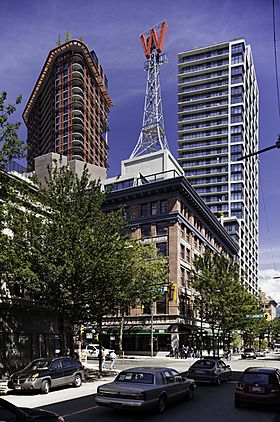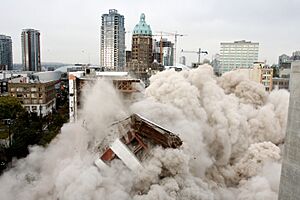Woodward's Building facts for kids
Quick facts for kids Woodward's Building |
|
|---|---|

Woodward's Building
|
|
| Alternative names | W Building |
| General information | |
| Type | Mixed-use |
| Architectural style | Postmodern / Structural Expressionism |
| Location | 128 West Cordova Street Vancouver, British Columbia |
| Coordinates | 49°16′56.2″N 123°6′26.5″W / 49.282278°N 123.107361°W |
| Opened | 1903 |
| Demolished | 30 September 2006 |
| Technical details | |
| Floor count | 12 |
| Floor area | 113,549 m2 (1,222,230 sq ft) (pre-2006) |
The Woodward's Building is a famous old building in Vancouver, British Columbia, Canada. It's located in an area called the Downtown Eastside. This building was first built in 1903 for the Woodward's Department Store. Back then, this part of Cordova Street was the main shopping area in Vancouver.
Woodward's was once the best place to shop in the city. It was well-known for its amazing Christmas window displays. People also loved its huge basement Food Floor. The big "W" sign on top of the building was a special landmark in Vancouver's skyline. After the Woodward's store closed in 1993, the building was empty for a long time. Later, people worked together to bring the building back to life. Now, many people live and work in the new buildings on this site.
Contents
History of the Woodward's Building
How the Store Started
The Woodward's Building was built in 1903 by a man named Charles A. Woodward. It was the second store for his Woodward's department store. Woodward's was one of the first stores to offer "one-stop shopping." This meant you could buy almost anything there!
The store had a huge food section, which was the biggest supermarket in North America at the time. You could also find household items, clothes for men and women, and even cash cheques or book travel. Woodward's was famous for selling many unique items you couldn't find anywhere else. The store quickly became very popular in Vancouver. It grew bigger over 12 different stages, eventually reaching 12 floors. It covered about two-thirds of the city block! Many other businesses opened nearby because Woodward's attracted so many shoppers.
Building Features and the "W" Sign
The building grew over many years, so different parts were built at different times. Most of the building used strong concrete. However, the very first part, built from 1903 to 1908, used huge wooden beams. These beams came from the very large, old trees that grew near Vancouver back then. Much of the building was not for shoppers. There were many hidden stockrooms and offices behind the scenes.
In 1944, the famous "W" sign was put on top of the building. It sat on a 25-meter tall replica of the Eiffel Tower. Before that, there was a searchlight beacon on top. This beacon was so bright it could be seen from far away towns like Abbotsford and Mission. But it was turned off at the start of World War II. This was because it could have been used by enemy planes as a guide for attacks.
Why the Store Closed
Over time, Woodward's started to lose customers. In the 1960s, many people began shopping at large shopping malls in the suburbs. Other big stores also moved away from the downtown area. This made West Hastings Street, where Woodward's was located, less popular for shopping. Also, many factories and jobs left the old city center. This meant fewer working-class families lived nearby, and Woodward's lost many customers.
In the 1980s, Woodward's sold its famous food floor to Safeway. The food floor then became an IGA store. Around the same time, the area around the Woodward's building started to become less busy and prosperous. Finally, in 1993, Woodward's went out of business and closed its doors for good. Many of its other stores were sold, but no one wanted the old downtown building. The closing of Woodward's made the area decline even faster.
Bringing the Building Back to Life
Early Plans for the Building
In 1995, a company bought the empty Woodward's building. They planned to build private homes there. But many people in the neighborhood disagreed. They felt it was important to include affordable housing for people who needed it. The government of British Columbia offered to help pay for some affordable housing. However, the company and the government couldn't agree, so the plan didn't happen. The building stayed mostly empty, except for sometimes being used for filming movies. In 2001, the government bought the building for $22 million. They tried different ideas to develop it, but in early 2002, the new government stopped the project.
In the fall of 2002, a small group of community activists took over the empty building for a week. They did this to ask the government for affordable housing. After the police made them leave, they set up a tent city on the sidewalks around the building for three more months. This event is known as the "Woodsquat." Many people say it helped start the process of finally redeveloping the building.
Community-Led Redevelopment
In 2003, the City of Vancouver bought the building from the province for $5 million. The city then asked the community what they wanted for the building's future. After a competition, the city chose Westbank Projects/Peterson Investment Group to develop the project. They worked with the architecture firm Henriquez Partners.
This huge project cost $400 million and covers nearly one million square feet. It includes 536 market housing units and 200 affordable housing units. It also has a grocery store (Nesters Market), a London Drugs, a bank (TD Canada Trust), and offices for the National Film Board of Canada. There's also a daycare, a public open space, and a new large addition for Simon Fraser University's downtown campus. This part is for the SFU School for Contemporary Arts.
On September 30, 2006, most of the old Woodward's building was carefully taken down. This was done with a "roll-over" implosion. Only the oldest part of the building, built from 1903 to 1908, was left standing. This marked the start of building the new complex.
The New Woodward's Building Today
Construction on the new building began in January 2007. It was mostly finished by September 2010. The famous "W" neon sign that was on top of the old building was taken down before the demolition. A new, energy-saving LED "W" sign was made and put back on January 9, 2010. The original "W" sign is now on display in an open area inside the new building.
In 2008, a Vancouver artist named Stan Douglas created a huge picture on glass. It shows the Gastown Riots from 1971. This large photograph, along with a basketball hoop, is now a main feature in the open area of the new Woodward's Building.
Images for kids




